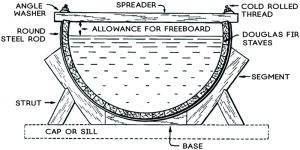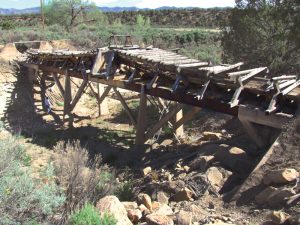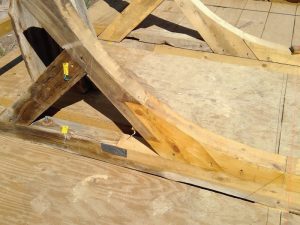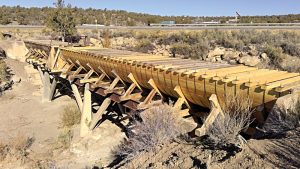The Montezuma Valley Irrigation Company Flume No. 6, also referred to as the McElmo Creek Flume (the Flume), located near the City of Cortez in Montezuma County, Colorado, is the last remaining flume of a water delivery system designed to irrigate the flat, open Montezuma Valley. The Flume is historically significant as an irrigation system of early Euro-American settlement.
Located in southwestern Colorado, the Flume is in an arid area with archaeological evidence suggesting that the earliest permanent settlement began around AD 400 when Ancestral Puebloan people began to occupy the Mesa Verde area. They depended on agriculture as their primary source of food, but due to the lack of a permanent water source in the area, rain and snow were critical to the growth of crops and their long-term survival. In the 1760s, Spanish expeditions brought the first Europeans to this part of the Southwest, and ranchers, farmers, and Pueblo traders settled the Montezuma Valley in the 1870s. Although many natural drainages occur in the valley, including the McElmo Creek, these drainages are seasonal and could not provide a steady water supply to farmers and settlers. As a result, several entrepreneurs began to develop a water system to irrigate the valley.
When the McElmo Flume was first constructed, it was described as a “4-feet by 18-feet [sic] wooden flume” (Engineering World 1922) supported by a wood substructure. At the time, a wooden box flume or rectangular flume was a popular choice in the West. Standard practice was to cover the surfaces with paint, hot asphalt, or tar to delay decay – creosoting was known to add life to the timber but was generally too expensive in the late nineteenth century. The original flume was in service until 1921, when it was replaced with a “semi-circular wood-stave flume, 10-foot diameter” (Engineering World, 1922). The new flume was constructed with creosoted Douglas-fir staves supplied by the Continental Pipe Manufacturing Company based in Seattle, Washington; it spanned the arroyo on wooden trestles and passed over low land on timber foundations. The flume consisted of timber bents – each comprised of two segments, two struts, one base, and a sill – providing support to the semi-circular stave configuration that was reinforced with spreaders and steel tie rods matching the diameter of the flume (Figure 1). The Flume was supported initially on timber girders, which were replaced by steel beams and concrete piers in 1955. In its current configuration, the Flume is approximately 10 feet wide by 100 feet long and constructed of 18 timber bents resting on steel I-beams and timber stringers supported by concrete-encased steel columns and diagonal braces. Although the irrigation system was no longer operational, water continued to flow through the McElmo Flume until 2007.

Over time, the Flume suffered from lack of maintenance and damage by severe natural events, including runoff from a heavy rainstorm in 2006 that collapsed its northern section and strong winds in 2010 that damaged staves and bents on the southern section. Prolonged exposure to severe weather resulted in corrosion of the steel elements, concrete spalling, and scour of the foundation. As a result, by 2012, the Flume was at risk of collapse.
The Evaluation of the Flume
It was critical to document the existing structure to develop a preservation plan (Anthony & Associates, Inc., 2013). The extant elements and those displaced but still nearby were recorded via LIDAR scanning, providing a record of the Flume site in 2012 (Figure 2). For the basis of design used in the structural analysis, the flume was analyzed to no longer carry water, so the loads were less than when operational and determined to be the dead load (weight of the structure) and live load (wind) for the preserved structure. The sizing of elements and design properties were based on satisfying the anticipated loads over a 50-year service life. The material assessment and evaluation were used to establish minimum sizing and material properties.

Wood Condition Assessment
The wood assessment was carried out to determine the suitability of the elements for reuse and continued service. Although the Flume no longer carried water, the wood elements still needed to support their own weight and resist wind loads to reduce the likelihood of additional collapse and loss of historical material. Initially, a visual inspection of the accessible elements was conducted to identify missing, broken, or deteriorated components. Visual inspection and probing with an awl quickly identified areas that needed further investigation to determine the extent of material loss due to wood decay. This was accomplished using resistance drilling – a quasi-nondestructive technique used to detect internal voids by determining the relative density of the wood as a small diameter needle penetrates the element. Next, wood samples were removed for species identification, and in-situ visual grading was conducted to determine the grade of structural elements. Identifying wood species and structural grade made it possible to assign design properties for conducting a structural analysis and identifying compatible material for repairs.
Wood condition varied from good to poor, with 40% of the timber in the bents in an advanced state of deterioration. Approximately 50% of the staves required replacement because they were missing or substantially damaged. The staves were identified as Douglas-fir and had evidence of creosote visible in the cellular structure, consistent with documentation that the flume box was purchased from the Continental Pipe Manufacturing Company. All other sampled elements (stringers, bents, and spreaders) were identified as a western yellow pine, suggesting that these elements may have been cut from locally available Ponderosa pine. The staves were free of knots and slope of grain and assigned the grade of Select Structural Douglas-fir. The timbers were assigned No. 2 Western Woods, excluding sills and stringers that did not meet structural grade requirements due to large knots or steep slope of grain.
Concrete and Steel Evaluation
The evaluation of concrete and steel focused on concrete cracking and spalling, steel corrosion, and foundation erosion. Condition assessment was based on visual methods supplemented by nondestructive techniques. Sounding of the concrete was done on representative elements to determine the presence and extent of delamination. A metal-detecting pachometer was used to scan concrete elements to locate embedded metals such as ties and reinforcing steel. An ultrasonic thickness meter was used to measure the steel thickness of the existing structural elements and evaluate the degree of section loss due to corrosion.
Extensive concrete spalling and cracking of the concrete-encased steel columns and diagonal braces were observed throughout the structure. However, the condition was particularly severe at the diagonal braces, where the full length of the steel beams was left exposed. Concrete columns were also affected by vertical cracking, typically in line with the embedded steel. The corrosion of the embedded steel caused the concrete deterioration. Minimal concrete cover, measured at ¾ of an inch at most locations, did not adequately protect the steel. The level of corrosion varied from minor (surface pitting) to moderate (flaking, less than 15% loss of original material) to severe (flaking, more than 15% loss of original material).
Girders were in fair to good condition, with minor surface corrosion and an average thickness loss of 12%. However, severe corrosion of the columns and braces resulted in reductions in the original thickness of 25% or more (based on measurements with an ultrasonic thickness gauge). In addition, severe corrosion was observed at all the plates that supported the wooden stringers, which, in some cases, produced substantial uplift of the stringers.
The foundation of the Flume was compromised due to severe runoff of the creek, with the bank of the arroyo eroded from beneath the abutment on the southeast end of the Flume, leaving the supports hanging in space.
Preservation Plan and Repair Work
Because of the National Register status of the Flume, the preservation plan followed the principles of minimal intervention as defined in the Secretary of the Interior’s Standards for the Treatment of Historic Properties. Withholding treatment was not an option since it would result in the loss of the Flume. The preservation goals were to maintain the original appearance of the Flume, allowing for interpretation of the history of water use in Montezuma Valley, with a service life of 50 years with minimal maintenance. Two intervention options were identified: stabilizing the Flume in its current condition and mitigating future deterioration, or, through rehabilitation, repairing the structure using the remaining original elements and augmenting it with new, in-kind elements as necessary. The rehabilitation option was selected by Montezuma County officials, the stewards of the Flume.
The work was completed in two phases: The treatment of the substructure included the construction of concrete footings for the unsupported bents and the placement of rip-rap to stabilize the arroyo bank during high runoff events. The concrete and steel elements were repaired so that support for the wooden flume superstructure was maintained. Deteriorated concrete was removed, encased steel cleaned, and the exposed surfaces prepared to receive patching material; new concrete was used to restore the original cross-section. The heavily corroded steel plates that supported wood stringers were replaced with self-weathering steel plates.
Finally, the flume timbers were repaired, and the stave pipe was reinstated using salvaged and supplemental staves. Surviving historical elements were numbered and disassembled, so deteriorated elements could be repaired with dutchmen and splices or replaced in kind (Figure 3). Salvaged staves, supplemented with new staves matching the original profile, were installed to complete the half-pipe and engage the steel rods and spreaders.
Conclusions
The McElmo Flume is a significant infrastructure feature that facilitated the settlement of the Montezuma Valley in southwest Colorado. It is the last remaining flume of an extensive irrigation system developed in the late 1800s. After a comprehensive material and structural assessment and the development of a preservation plan, the Flume was repaired, maximizing the retention of historical material (Figure 4). This engineering achievement helps to tell the history of water in the development of Montezuma County.■
References
Engineering World 1922. Engineering World: A Journal of Engineering and Construction.
Catalog No. 18: Continental Wire Wound Wood Pipe, Continental Continuous Stave Wood Pipe, Continental Creo-Wood Flume, Continental Pipe Manufacturing Co, 1923.
Kay D. Weeks and Anne E. Grimmer (1995). The Secretary of the Interior’s Standards for the Treatment of Historic Properties with Guidelines for Preserving, Rehabilitating, Restoring & Reconstructing Historic Buildings. Washington, D.C., U.S. Department of the Interior, National Park Service, Cultural Resources, Preservation Assistance Division.
Anthony & Associates, Inc. 2013. Foundation Assessment and Construction Documents for the McElmo Creek Flume (5MT20000), Montezuma County, Colorado.


